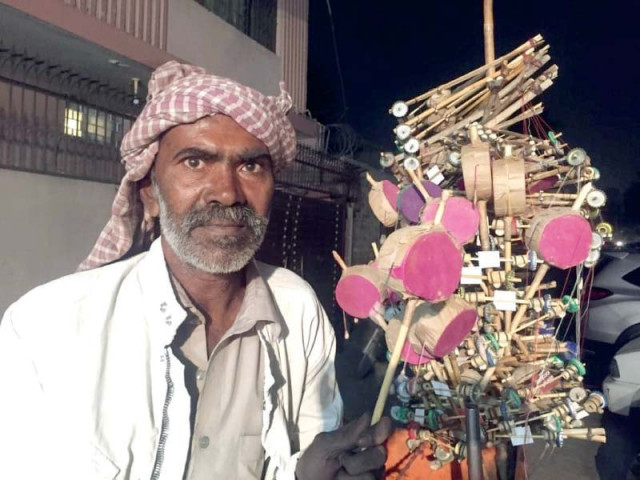Clay toys – a dying tradition
As children growing up in urban settings prefer modern, sophisticated toys

Zulfiqar with his inventory of clay toys. PHOTO: EXPRESS
As a result of technology, the ancient tradition of making clay toys has almost diminished. Earthenware toys have existed in almost every culture of the world and people have been making toys following their traditions and rituals so that local culture would be passed on to the next generation.
In the past, parents would gladly buy clay toys for their kids but with the market shelves flooding with modern playthings, both parents and children are least interested in spending money buying clay toys.
Alternate Medicine: Patients turn to traditional medicine to treat dengue
A survey conducted by The Express Tribune revealed that when children aged three to five were asked about clay toys, they did not even know that such things even existed.
“It is absurd to expect children to know about clay toys when they have so many options to choose from,” Syeda Farah Inam, a mother of three children said. “Nowadays, children like to play with remote-controlled cars, planes, dancing dolls and different types of guns. In fact, when I was a kid, I don’t remember playing with clay toys either. It must have been an ancient tradition.”
Ali Khan, who is a father to a five-year-old boy, said that children these days are not even interested in conventional toys like dolls and cars anymore, let alone toys made of clay or wood.
“Most children these days want to play with smart gadgets like tablets and sophisticated videogames,” he said. “In the West, children are being exposed to virtual reality (VR) games. Soon, the trend will come to developing countries too. Who will pay heed to clay toys in this day and age?” Ali Khan questioned.
Murtaza Bhatti, a toy store owner, said that as against urban children, kids in villages still prefer to play with clay toys despite the availability of toys and cars.
“I think socio-economic factors also play a big part in what type of toys children own and play with. In villages, many children still play with wooden and clay toys, as well as handmade dolls because they cannot afford modern toys,” Bhatti said.
An artisan named Zulfiqar, whose family has been involved in making clay toys since many generations, said that even though it is very difficult to sell clay toys because children don’t seem to be interested in them anymore, he still has a passion for making and selling before-mentioned toys.
Darra’s warrior beats polio
“Clay toys are very cheap as we can make up to a hundred toys by investing just Rs400,” he said, “A single clay toy, which could be anything from a doll to a horse, to a car, would only cost Rs20 to Rs50.”
Elaborating his work, he added that he bought the tools and goods used in the preparation of clay toys from Bhalwal – a tehsil in Sargodha District, Punjab.
“I sell clay toys from 4 PM to 11 PM in the areas of Lalkurti, Dheri Hassanabad, and Dhoke Hassu, among others, every day.”
He said that he chooses late hours because children usually play on the streets at night time and parents readily buy toys for them.
“Even though the world is moving towards modern technology, when I see kids from poor families happily playing with clay toys, it brings me a sense of satisfaction to spread smiles on their innocent faces.”
Published in The Express Tribune, November 3rd, 2019.


















COMMENTS
Comments are moderated and generally will be posted if they are on-topic and not abusive.
For more information, please see our Comments FAQ